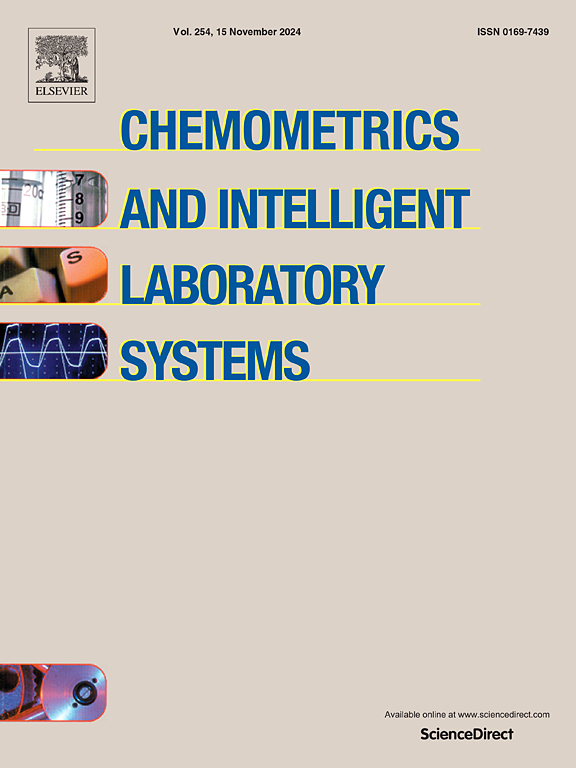Gaussian mixture model clustering allows accurate semantic image segmentation of wheat kernels from near-infrared hyperspectral images
IF 3.7
2区 化学
Q2 AUTOMATION & CONTROL SYSTEMS
Chemometrics and Intelligent Laboratory Systems
Pub Date : 2025-02-07
DOI:10.1016/j.chemolab.2025.105341
引用次数: 0
Abstract
In this study, an ad-hoc image processing pipeline has been developed and proposed for the purpose of semantically segmenting wheat kernel data acquired through near-infrared hyperspectral imaging (HSI). The Gaussian Mixture Model (GMM), characterized as a soft clustering method, has been employed for this task, yielding noteworthy results in both kernel and germ segmentation. A comparative analysis was conducted, wherein GMM was compared with two hard clustering methods, hierarchical clustering and k-means, as well as other common clustering algorithms prevalent in food HSI applications. Notably, GMM exhibited the highest accuracy, with a Jaccard index of 0.745, surpassing hierarchical clustering at 0.698 and k-means at 0.652. Furthermore, the spectral variations observed in wheat kernel topology can be used for semantic image segmentation, especially in the context of selecting the germ portion within the wheat kernels. These findings carry practical significance for professionals in the fields of hyperspectral imaging (HSI) and machine vision, particularly for food product quality assessment and real-time inspection.
高斯混合模型聚类可以对近红外高光谱图像中的小麦籽粒进行准确的语义图像分割
为了对近红外高光谱成像(HSI)获取的小麦籽粒数据进行语义分割,本研究开发并提出了一种自适应图像处理流水线。采用软聚类方法的高斯混合模型(Gaussian Mixture Model, GMM)在核和芽的分割上都取得了显著的结果。通过对比分析,将GMM与两种硬聚类方法分层聚类和k-means聚类以及食品HSI应用中常见的其他聚类算法进行了比较。值得注意的是,GMM具有最高的准确性,其Jaccard指数为0.745,超过了分层聚类的0.698和k-means的0.652。此外,在小麦籽粒拓扑结构中观测到的光谱变化可以用于语义图像分割,特别是在选择小麦籽粒内胚芽部分的背景下。这些发现对高光谱成像(HSI)和机器视觉领域的专业人员,特别是食品质量评估和实时检测具有实际意义。
本文章由计算机程序翻译,如有差异,请以英文原文为准。
求助全文
约1分钟内获得全文
求助全文
来源期刊
CiteScore
7.50
自引率
7.70%
发文量
169
审稿时长
3.4 months
期刊介绍:
Chemometrics and Intelligent Laboratory Systems publishes original research papers, short communications, reviews, tutorials and Original Software Publications reporting on development of novel statistical, mathematical, or computer techniques in Chemistry and related disciplines.
Chemometrics is the chemical discipline that uses mathematical and statistical methods to design or select optimal procedures and experiments, and to provide maximum chemical information by analysing chemical data.
The journal deals with the following topics:
1) Development of new statistical, mathematical and chemometrical methods for Chemistry and related fields (Environmental Chemistry, Biochemistry, Toxicology, System Biology, -Omics, etc.)
2) Novel applications of chemometrics to all branches of Chemistry and related fields (typical domains of interest are: process data analysis, experimental design, data mining, signal processing, supervised modelling, decision making, robust statistics, mixture analysis, multivariate calibration etc.) Routine applications of established chemometrical techniques will not be considered.
3) Development of new software that provides novel tools or truly advances the use of chemometrical methods.
4) Well characterized data sets to test performance for the new methods and software.
The journal complies with International Committee of Medical Journal Editors'' Uniform requirements for manuscripts.

 求助内容:
求助内容: 应助结果提醒方式:
应助结果提醒方式:


